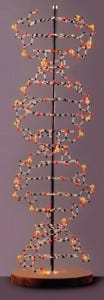https://bioprocessintl.com/wp-content/uploads/2014/09/092014_Locwin.mp3

For decades, professional biology education programs, universities, community colleges, and some high schools have inoculated students with the phrase central dogma to refer to the basic paradigm that “DNA encodes RNA, which encodes for protein” (1). Although that is in large part true, we do need to break with tradition, let science take its course, and call it like it is.
Background
In 1970, Francis Crick’s seminal paper in Nature (“Central Dogma of Molecular Biology”) was published. Eventually its premise was swept up in the imagination of the nation and the world (2). In that paper, Crick erroneously used the phrase central dogma to refer to this oft-seen relationship between deoxyribonucleic acid (DNA), ribonucleic acid (RNA), and proteins. Without getting caught up in the nuances and advances we’ve elucidated about the nature of protein coding since 1970, we need to move our field forward and change the formative education of these principles to get away from this naming convention.
So What’s the Problem?
That simplistic explanation is still being taught as the “central dogma” of molecular biology. But we’re doing science a disservice by misbranding an important set of pathways, and we’re doing semantics a disservice by misusing words in such a way as to reduce their impact.
The Oxford American Dictionary defines a dogma as a noun that describes a “principle or set of principles laid down by an authority as incontrovertibly true.” But our “central dogma” is certainly not incontrovertibly true. In fact, as with anything we think we know in science, it’s only a best approximation to the way nature really is as best we know it at the moment.
Major paradigm shifts and usurpations of prior thought happen throughout the history of science — generally in a staccato manner that’s punctuated by long periods of status quo. In fact, we do ourselves and science a disservice by attempting to make claims seem too substantial (usually when trying to appeal to public interest) by saying that something has been “proven.” Indeed, science doesn’t seek to “prove” itself or any claims, only to transparently formulate hypotheses and observe and collect data to amass evidence suggesting that something behaves in a certain way — or doesn’t.
In science, we proceed along a path that was long ago paved by famous luminaries. Galileo himself (who established many of the paradigms that we still follow in experimentation for scientific practice) had this to say: “In questions of science, the authority of a thousand is not worth the humble reasoning of a single individual . . . modern observations deprive all former writers of any authority, since if they had seen what we see, they would have judged as we judge” (3). When viewing Jupiter and its now eponymous “Galilean” moons — Io, Europa, Ganymede, and Callisto — for the first time through his telescope (along with other observational discoveries), Galileo said that he had “oculata certitudine” (visible certainty) regarding the motion of planetary bodies outside the Earth.
In his own words from 1610, he describes the use of scientific practice to advance knowledge (5): “quam Perſpicilli beneficio adeò ad ſenſum licet intueri, vt & altercationes omnes, quæ per tot ſæcula Philoſophos excrucia runt ab oculata certitudine dirimantur, nosque à verboſis dſputationibus liberemur.” Translated, that is “with the aid of the spyglass, may be observed so well that all the disputes that for so many generations have vexed philosophers are destroyed by visible certainty, and we are liberated from wordy arguments.”
I hope we can make such changes to our own discussions of biology in the interest of proper science — and not wait, as in 1948 Max Planck suggested often occurs (5): “A new scientific truth does not triumph by convincing its opponents and making them see the light, but rather because its opponents eventually die, and a new generation grows up that is familiar with it.” Even Crick himself stated in his autobiography that he shouldn’t have used the phrase central dogma (6).
References:
1 Crick FHC. On Protein Synthesis. Symp. Soc. Exp. Biol. XII 1958: 139–163.
2 Crick F. Central Dogma of Molecular Biology. Nature 227(5258) 1970: 561–563.
3 Galilei G. Sidereus Nuncius. 1610 — as translated in Sidereus Nuncius Albert Van Helden, trans. University of Chicago Press: Chicago, IL, 1989; 62.
4 Third Letter on Sunspots (December 1612) to Mark Wesler (1558–1614) — as quoted in Drake S. Discoveries and Opinions of Galileo. Anchor Press: Norwell, MA, 1957; 134–135.
5 Wissenschaftliche Selbstbiographie. Mit Einem Bildnis und der von Max von Laue Gehaltenen Traueransprache. Johann Ambrosius Barth Verlag: Leipzig, Germany 1948; 22 — as translated in Scientific Autobiography and Other Papers, Gaynor F, trans. Greenwood Press: New York, 1949; 33–34.
6 Crick F. What Mad Pursuit: A Personal View of Scientific Discovery. Basic Books: New York, NY, 1988.
Dr. Ben Locwin is site head of training and development, risk and decision sciences as well as senior QA pharma biotech quality assurance Lonza Biopharmaceuticals, 101 International Drive, Portsmouth, NH 03801; 1-603-610-4682; [email protected]; www.lonza.com.








